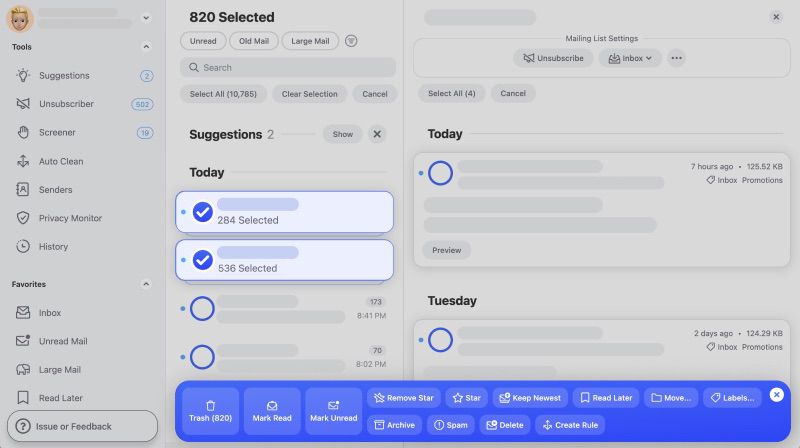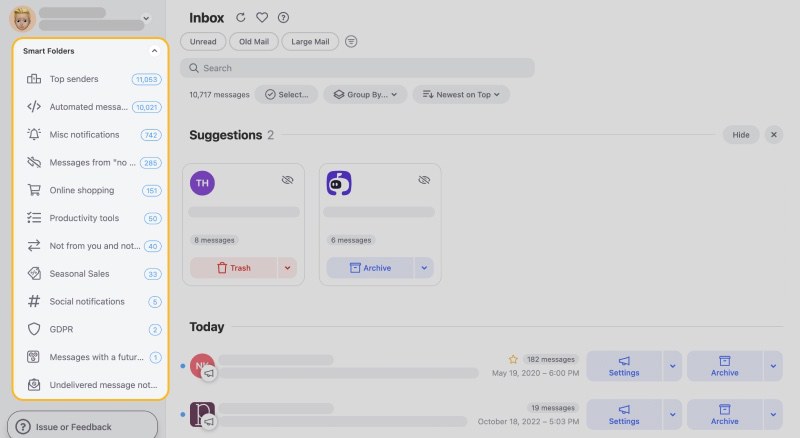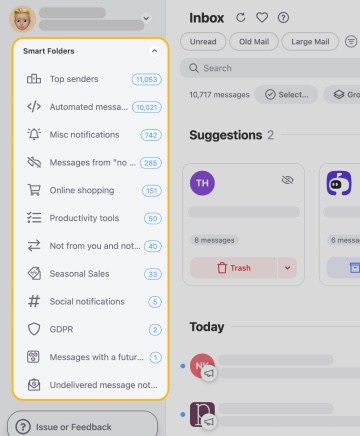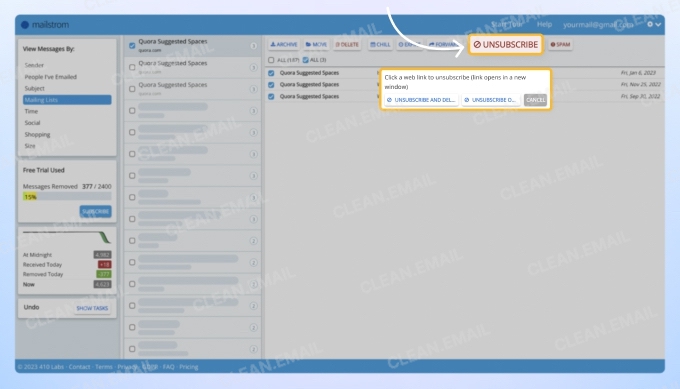What Is an Email Organizer?
An email organizer app helps you organize email and clean your inbox for a more productive experience. The best email organizers support all major email providers, including Gmail, Yahoo, Outlook, AOL, Fastmail, and iCloud. Some email organizers are available as desktop applications, but most now use the SaaS (Software as a Service) model, in which software is licensed on a subscription basis and is centrally hosted.
Check out our in-depth video review of the best email organizers and keep reading for more details.

You can try most email organization apps for free, and if you like it, you can pay for a premium subscription plan. Considering the average office worker receives more than 100 emails daily, you can see where an inbox organizer is crucial. Businesses and individuals both benefit from using a mailbox organizer app.
Some of the key decision-making factors that earned an app the right to be on this list of the best email organizers are:
- Powerful organization features like advanced sorting and automation.
- User-friendly app.
- Good customer support.
- Support for all major email platforms.
- Free trial.
- Affordable monthly plans.
We have thoroughly tested and evaluated each of the apps mentioned in our best email organizer list so you can make an informed decision and start organizing your inbox today.
Top 8 Best Email Organizer Apps
Here's a quick rundown of the top 8 email organizers and their key strengths:
- Clean Email: Comprehensive inbox organization.
- Shortwave: AI-driven Gmail organization.
- Mailbutler: Collaborative email enhancement tool.
- Mailstrom: Efficient bulk email management.
- SaneBox: AI-based email sorting.
- Drag: Gmail productivity and collaboration.
- ActiveInbox: Gmail task management integration.
- Spark: Multi-platform, feature-rich email organization.
1. Clean Email
Our choice for the best app for organizing emails is Clean Email, hands down. The app was designed for people who want to achieve Inbox Zero with minimal effort. It works on all devices—including iPhone, Android, Mac, and any web browser—and popular providers like Yahoo, Gmail, iCloud, Hotmail, AOL, Office 365, and Outlook.
Clean Email uses sophisticated algorithms to analyze email headers that contain subject lines, sender and recipient information, dates, message size, and other metadata. This approach allows the app to intelligently group and simplify the organization of your messages, making bulk actions more efficient.


Two of the standout features of Clean Email are Smart Folders and Auto Clean. Smart Folders automatically organize your inbox into logical categories like Top Senders, Social Notifications, Automated Messages, Finance (anything related to banks or money), and more. Auto Clean uses automated rules that you set up to filter incoming messages and sort them where you want. You can then experience a clean inbox and review your emails on your own time.


Learning how to organize your email with this app takes just a few minutes. To get started, all you have to do is sign in with your email service provider and authorize the app to access it. Clean Email will automatically analyze your emails and categorize them into easy-to-review bundles. You can then remove, archive, move, label, and do other things with entire groups of emails instead of selecting individual emails one by one.
Clean Email recently added new features that allow you to reply, send, and forward emails in the latest product update. Clean Email continuously adds new features, making a great product even better.
- Powerful inbox management and organization features.
- Advanced filtering and sorting options.
- Automatic email organizing with Smart Folders.
- Action History Summary to keep track of the actions taken in the app to avoid missing anything important.
- Control Center.
- Lack of AI-based features.
- There is no dedicated app for Windows desktops.
Clean Email offers a free trial to get you started and three premium account options depending on the number of users. You can check the plans available here.
2. Shortwave
Shortwave is an email organizer for Gmail. It uses AI to discover insights into your email habits and history to simplify bundling similar emails into folders so you can choose to deal with them when you want, keeping your inbox clean.

Shortwave was developed by ex-Google employees attempting to re-create the old Google Inbox app. Some features include a snooze button, pinning emails to the top of your inbox, and one-click block and unsubscribe.
A distinctive feature that sets Shortwave apart from the competition is its Ghostwriter feature, which uses AI to draft emails in your voice. Shortwave is compatible with every language and interfaces seamlessly with Google Calendar, so you can easily schedule meetings. You can even delay messages using the delivery feature, so you only receive emails when you want to.
- Feature-rich.
- AI-enabled.
- Bundles emails into categories automatically.
- Receive messages when you want with schedules.
- Keyboard shortcuts.
- Limited to the Gmail platform only.
- No desktop apps.
Shortwave offers you a free (limited) trial version. Then, you can choose from three subscription plans starting at $7/month up to $24/month. As you go up in tiers, you enjoy more features and a larger number of users.
3. Mailbutler
Mailbutler is an email extension that you can use to enhance your mail provider with new features. It works with Outlook, Gmail, and Apple Mail. Some powerful options are email tracking, signatures, scheduled sending, delayed email delivery, notes, contacts, tasks, templates, and an AI-powered email assistant.
Mailbutler aims to be a collaborative environment where you can work on notes, tasks, contacts, and templates with team members. In terms of organizing email, the app uses tags to organize emails into groups. The company uses sophisticated encryption and complies with European data regulations to protect your privacy.
Compared to Clean Email and other inbox organizers, Mailbutler lacks some critical features. It does a lot to help you collaborate with other users and craft error-free emails, but its main focus is not blocking or organizing emails. It strives to be a one-stop shop for everything email-related but lacks in-depth organization features.
- Email tracking.
- Collaboration features.
- AI-empowered for email insights.
- Tags to organize emails.
- Works on all leading email platforms.
- Built-in grammar checker.
- Pricey (based on number of users).
- The user interface needs updating.
- Doesn’t work on iOS or iPad OS.
Mailbutler offers a 14-day free trial version, and after that, you must pay $4.95/per user/month, up to $32.95/per user/month), depending on the features you want.
4. Mailstrom
Mailstrom is a powerful email organization app that cleans your inbox with a few clicks. The app makes unsubscribing and deleting emails a breeze. You can use bulk actions to remove or unsubscribe emails after Mailstrom groups related emails together.
Cleaning out thousands of emails at once is a snap. The email sorting app offers a one-click unsubscribe feature to eliminate spam and declutter your Inbox. Mailstrom uses industry-leading encryption to keep your personal information safe, and it works with Gmail, Outlook, Yahoo, and other IMAP-based mail providers.

What sets Mailstrom apart from other inbox organizer apps is its flexible tips, tricks, and hacks to make cleaning out your inbox fast and efficient. Some reviewers consider it one of the quickest Gmail organization apps on the market.
However, our research uncovered a drawback: in Mailstrom, emails can only be organized by the labels “Social,” “Shopping,” and “Mailing Lists.” In contrast, other email organizers like Clean Email offer more smart labels, which include categories like “Dead Ends,” “Seasonal Sales,” “Productivity Tools,” “Bounce Notifications,” “Travel,” and more. Clean Email's 33 Smart Folders greatly simplify the process of cleaning a messy inbox, a feature Mailstrom has yet to expand upon.
- Works with all IMAP-based mail providers.
- Delete thousands of emails with a few clicks.
- Strong encryption and never saves your password.
- Limited smart email bundles/folders.
- Lacks automation features and AI.
- Free trial is limited.
Mailstrom email organizer offers a free trial version that is limited to 2,500 emails. The brand also has paid subscription plans with various features ranging from $59.95/year to $199.95/year.
Learn why Clean Email is one of the best alternatives to Mailstrom.
5. SaneBox
SaneBox is an AI email organizer that works in the background behind your email provider, learning your email habits and sorting messages into relevant "Sane" folders.

The app was developed in 2010 and helps users identify important messages, hide distractions, banish annoying senders, and more. It works with all email addresses and can be used for free for 14 days. SaneBox is compatible with Gmail, Office 365, iCloud, and more.
SaneBox ranks lower in features and flexibility than similar products despite its heavy reliance on AI. Compared with Clean Email, SaneBox has significantly fewer email management features, and users have less control over automation.
To use SaneBox, sign in with your email address, let it create SaneBox folders, and wait for its AI to sort your emails. You can teach the AI by moving any misplaced message to the correct folder with any webmail/email client, but that's about it. Compared with Clean Email, SaneBox is limited and has only basic features. But the good news is that SaneBox can be used with Clean Email, which is far more effective when removing unwanted emails.
- “Interfaceless” inbox cleaner.
- Works with any email address.
- 14-day free trial.
- AI-based email sorting.
- Lacks flexibility.
- Only basic organization options.
After your free trial, you can choose three pricing options from $7/month to $36/month. Pricing is based on features and number of accounts.
6. Drag
Drag is a Gmail organizer app that adds dozens of new features to Gmail. It’s meant to be a collaborative team tool to enhance Gmail’s productivity. The custom automation feature allows you to organize emails effortlessly, follow up, and track specific emails from particular senders.
One of the most impressive features is setting shared inboxes so you don’t have to forward and cc messages back and forth; you can all work from the same information. Other features include email templates, tracking and sequencing, boards, aliases, team chat, assignments, and labels for organizing messages into groups.
Although this tool is packed with features, most do not apply to organizing email. Teams looking for a great way to collaborate will love the comprehensive options, but if you are looking for a simple yet effective app to organize and block emails to keep your inbox clean, this may not be the best email organizer app to choose.
- Collaborative features.
- Labels for organization.
- Sorting and filtering options.
- Automation.
- Integrations.
- Kanban boards.
- Limited to the Gmail provider.
- No mobile version.
- Can be buggy at times.
- Meant to be a collaboration tool, not an email organizer.
Drag has a free trial, or you can sign up for one of their three premium plans starting at $10/user/month up to $24/user/month.
7. ActiveInbox
Another email sorter app, ActiveInbox, aims to convert Gmail into a task manager. Instead of missing a crucial message as it sinks to the bottom of your inbox, ActiveInbox turns it into a task, so you never forget anything. You can track emails you send to follow up with people who didn’t respond. The app calls itself an “email client and task manager” all in one.

Use automation to move emails into folders so you can review them later. Or allow ActiveInbox to turn them into tasks to address so you won’t forget. The program creates Gmail folders and filters emails into them automatically, so you aren’t wading through 100s of messages a day.
When compared with Clean Email and Mailstrom, ActiveInbox falls short. ActiveInbox lacks automatic email organizing features. This requires users to organize emails manually, a process that can be particularly time-intensive at the outset.
- Works seamlessly with Gmail.
- Enhances Gmail with dozens of features.
- Turns emails into tasks.
- Add notes to emails.
- Sorts emails by sender or priority.
- Task manager.
- Works only with Gmail.
- Lacking email organization features.
- Confusing interface.
You can try a free trial of ActiveInbox and then sign up for their Professional Plan for $5.37/per account/month. You must contact them for an enterprise quote if you want business pricing.
8. Spark
Spark is an email organization app designed to block out distractions and help you focus on what is most important. You can prioritize certain contacts or pin specific emails to the top of your inbox. You can also group emails by sender, mark them as done, set them aside, or remind yourself to deal with them another time. The app works across platforms with Gmail, Microsoft 365, and Outlook (to name a few).

The app also includes an AI-powered writing assistant, so all your emails are grammatically correct and perfect before you hit send. The app offers helpful insights on improving your workflow and changing your email habits for increased productivity. You can also block and filter emails as they come in to keep you hyper-focused.
Spark is hailed as one of the most comprehensive email-enhancing apps out there. For simple decluttering, however, it may be overkill for some users.
- Automatically identifies important emails and separates them.
- Mute threads.
- Prioritize emails and contacts.
- Screen unwanted emails.
- Unified inbox.
- Smart search.
- Keyboard shortcuts.
- No web version.
- Could get pricey for teams.
Spark offers you a free limited trial version. Then, you can choose from an individual plan for $4.99/month or a team plan for $6.99/per user/month.
Follow our guides on how to organize iCloud emails, organizing Yahoo Mail, and the best email organizers for Mac.
Why Should I Use an Email Organizer?
An email organizer allows you to eliminate inbox clutter efficiently with just a few simple clicks. Instead of going through your emails one by one and manually separating the emails you want to keep from those that can be deleted, an email organizer app can analyze the headers of your emails and use the information to organize them into easy-to-review bundles.
Many people waste hours trying to figure out how to manually organize their inbox in hopes that it won’t become cluttered again. Unfortunately, that’s not the way it works. Clean Email and other advanced email organizers provide useful tools to help you maintain a clean inbox today and every day going forward.
Don’t waste time wondering how to organize your work email; instead, start using Clean Email today and use automation to quickly and easily get things under control and keep them that way. All your emails will seamlessly flow into the correct folder so you can review them when you are ready.
💡 Let’s say that each message you receive takes you just 5 seconds to organize manually. If you, like most people, receive around 100 emails a day, you spend 500 seconds, or a little over 8 minutes, every day on email management alone. That may not seem like much at first, but consider that 8 minutes of email management a day adds up to more than 2 days over the course of a year. That’s a lot of wasted time that can be saved virtually without effort just by using an email organizer app.
Email Organization Makes Sense!
Hopefully, this list of email organizers has helped you decide which is the best email organization system for you. Email isn’t going away anytime soon, and the number of daily spam emails keeps rising. Using a great app to organize emails just makes sense. Clean Email is the best email app for organizing your entire inbox. Wake up to a decluttered, organized inbox every day, regardless of how many emails you receive. Try it today for FREE.
Wondering how to organize Outlook email inbox or how to organize Gmail? Check out our blog to get the detailed guidance.


